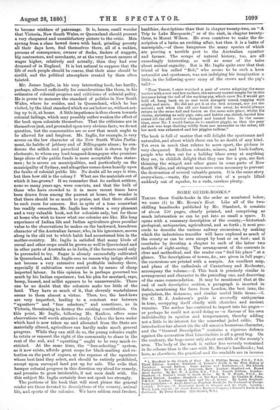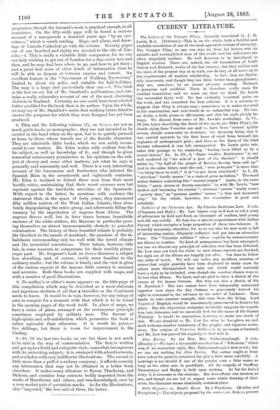SOME GUIDEBOOKS.*
TAKING these Guide-books in the order as numbered below; we come (1) to Mr. Bevan's Kent. Like all of the two- shilling handbooks published by Mr. Stanford, it consists of about 150 pages, clearly printed, and comprising as much information as can be put into so small a space. It opens with a summary description of the county,—historicah geological, antiquarian, agricultural, and so forth ; it next pro- ceeds to describe the various railway excursions, by making which the industrious traveller will have explored as much of the county as can be seen except by boat or on foot; and it concludes by devoting a chapter to each of the latter two • methods of sight-seeing. The arrangement of the contents is clear and methodical, and the reader can " find his place" at a glance. The descriptions of towns, &c., are given in full page ; ' the excursions are printed with a margin. An excellent map, and plans of the cathedrals of Canterbury and Rochester, accompany the volume.-2. This book is precisely similar in arrangement and character to the preceding one, and deserving of the same commendation. It may be mentioned that at the end of each descriptive section, a paragraph is inserted in italics, mentioning the fares from London, the best inns, the population, the distances, and similar useful little items.-3. Sir C. H. J. Anderson's guide is avowedly antiquarian in tone, occupying itself chiefly with churches and ancient remains. The author has contrived to import into his pages— or perhaps he could not avoid doing so—a flavour of his own individuality in opinion and. temperament, thereby adding •
not a little to its interest for the somewhat jaded critic. The introduction has almost (in the old sense) a humorous character, and the "General Description" contains a vigorous defence against the accusation that Lincolnshire is all a great bog. On the contrary, the bogs cover only about one-fifth of the county's area. The body of the work is rather less severely restrained in its scheme than is the case with Mr. Bevan's handbooks ; but here, as elsewhere, the practical and the readable are in inverse
• 1. Handbook to the County of Kent. By S. Phillips Bevan, F.G.S.. P.S.S. Third Edition. London : Stanford.-2. Tourist's Guido to the West Riding of Yorkshire. Second Edition. Same Author and Publishcre.-3. The Lincoln. Pocket Guide. By Sir C. H. J. Anderson, Bart. London : Stanford.-4. Bound about London. By Bey. W. J. Lottie. B.A., F.S.A. Fourth Edition. London : Stanford.-5. Tourist's Guide to South Devon. By R. N. Worth, F.G.S., &c. Second Edition. London : Stanford—S. The West Inches. By Charles H. Eden, F.R.G.S. London : Sampson Low and Co.—?. Greece. By Lewis Sergeant. Same pub1iehere.-8. Antis-American Practical Guide for the Continent of Europe. London : Illustrated Guide to Gtaxgote and the Clyde. London : Ward, Lock, and Co.-10. Great Eastern Railway CompanD's Tourist's Guide to the Continent. By Percy Lindley. (121 Strand, W.C.) proportion, though the baronet's work is practical enough, in all conscience. On the fifty-sixth page will be found a curious account of a masquerade a hundred years ago "by an eye- witness," which is worth reading. Maps, and plans, and draw- ings of Lincoln Cathedral go with the volume. Seventy pages out of one hundred and eighty are devoted to the city of Lin- coln.-4. This is really a valuable little companion, for no one can help wishing to getout of London for a day, every now and then, and he may find here where to go, and how to get there ; and a great deal more of other kinds of information than he will be able to dispose of between sunrise and sunset. An excellent feature is the "Specimens of Walking Excursions," limited to about six miles, and suitable for half-holidays. The map is a large and particularly clear one.-5. This book is the last on our list of Mr. Stanford's publications, and con- tains a really exhaustive account of one of the most charming districts in England. Certainly no one could have been selected better qualified for the:work than is its author. -Upon the whole, we may say of Mr. Stanford's series that nothing better fitted to answer the purposes for which they were designed has yet been produced.
6. This, and the following volume (7), on Greefe, are not so much guide-books as monographs ; they are not intended to be carried in the hand when on the spot, but to be quietly perused at home by those whose travels are of the fireside character. They are admirable little books, which we can safely recom- mend to our readers. Mr. Eden writes with evident love for his subject, as well as knowledge of it ; and though he gives somewhat unnecessary prominence to his opinions on the sub- ject of slavery and some other matters, yet .what he says is generally said reasonably and well. There is a very interesting account of the buccaneers and freebooters who infested the Spanish Main in the seventeenth and eighteenth centuries. Mr. Eden is inclined to defend these men from their most hostile critics, maintaining that their worst excesses were but reprisals against the inevitable atrocities of the Spaniards. With regard to the latter, he mentions with credence the statement that, in the space of forty years, they massacred fifty million natives of the West Indian Islands, thus abso- lutely depopulating the entire group, and afterwards filling the vacancy by the importation of negroes from Africa. The negroes throve well, but in later times became formidable enemies of the white settlers, the Maroons in particular prov- ing themselves an almost insurmountable obstacle to peaceful colonisation. The history of these beautiful islands is probably the bloodiest in the annals of mankind ; the passions of the in- habitants corresponding only too well with the torrid climate and the terrestrial convulsions. Their future, however, bids fair, in some measure, to compensate for their terribly pictur- esque past. Mr. Sergeant's book on Greece discusses a subject less absorbing, and, of course, vastly more familiar to the ordinary reader ; but the volume is timely, and the view it gives of the various aspects of the famous little country is succinct and accurate. Both these books are supplied with maps, and with a number of good illustrations.
8. No author's or editor's name appears on the title-page of this compilation, which may be described as a most elaborate and ingenious skeleton of all that a traveller on the Continent needs to know. It would be in vain, however, for any eulogy of ours to compete for a moment with that which is to be found in the opening pages of the work itself. In place of maps, we have a series of plans, arranged on the rectangular principle sometimes employed by military men. The flavour of high-spirits and self-satisfaction which permeates the book is rather agreeable than otherwise. It is worth its price,— five shillings, but there is room for improvement in the binding.
9-10. Of the last two books on our list there is not much to be said in the way of commendation. The first is written and got up in a florid and eulogistic style, somewhat incongruous with its uninviting subject ; it is swamped with advertisements, and overladen with very indifferent illustrations. The second is little more than a puff of a railway company ; it affords scarcely any information that may not be obtained in a better form elsewhere. It makes many allusions to Byron, Thackeray, and Dickens, and contains long extracts bodily imported from the works of Hawthorne and others, and unacknowledged, save by a very modest pair of quotation-marks. As for the illustrations, also " imported," the less said of them, the better.































 Previous page
Previous page